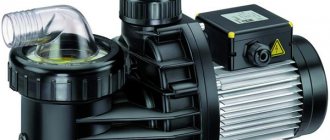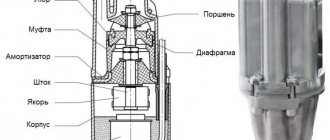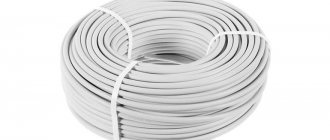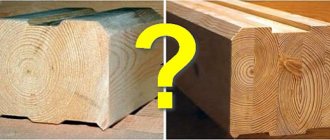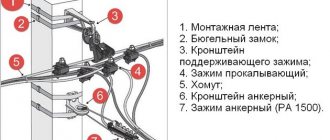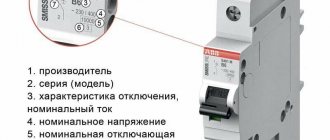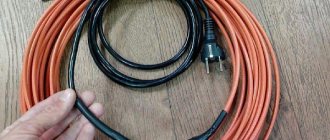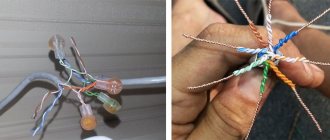Let's consider only those types of cable that most often need to be used when installing and replacing electrical wiring inside an apartment or house. Finding them in construction stores is not difficult.
However, when purchasing, you must know exactly what their letters in the abbreviation mean, when you need to use one or another brand, and whether it is possible to replace one cable with another if one of the types is not on sale.
Life time
The estimated service life of VVG and NYM cables is at least 30 years.
And if there are the most ordinary conditions and the absence of a nominal load, then maybe all 50! It is these two main brands of cable, discussed in detail in the article, that are the most suitable and popular for installing electrical wiring, connecting sockets, switches and lighting.
There is another brand different from the two above that you may need in small quantities. But this is not a cable, but a wire - PV-3.
It is flexible, multi-core, easy to bend in small spaces and convenient to connect to machines via NShVI lugs. That is why it is used in the assembly of electrical panels.
Well, in the end, we will give a decoding of all the meanings of the letters in the cable brands, which are widely applicable in our electrical networks.
Is it possible to carry out this without gating hidden walls?
Hidden wiring is carried out without gating.
Here the technology will be different, but the essence remains the same. However, the work must be completed before finishing the wall. Wiring is fixed to a bare wall, and places for installing sockets are prepared.
Once the power supply system is ready, you can begin plastering the walls. This way, the electrical wiring is hidden from view and there is no need to make grooves in the wall.
In this case, the thickness of the plaster on the wall is greater than with stenciling.
Anyone who has dealt with power tools can do the wiring with their own hands under the plaster. The main thing is to approach with accurate calculations and reliable tools. The tips from the article will help you carry out installation with minimal loss of resources and finances.
Which wire is better - the materials from which electrical cables are made
Anatomy of a wire
The main elements that make up the wire of an electric cable are the cores - elements for the passage of electric current, isolated from each other by an internal sheath and enclosed in a common sheath.
They are designated by the abbreviation TPG.
There are two types of such conductors for transmitting electrical energy:
- single-wire solid;
- stranded, consisting of a large number of thin threads.
There are two concepts that can be easily confused with each other: solid cores and solid cables. In fact, these are different things. Single-core products can have only one core, which, in turn, can be made single-wire or multi-wire.
The main material for the manufacture of current-carrying conductors: copper or aluminum. If we compare these metals, then aluminum, although it is cheaper, loses in that it has a lower level of electrical conductivity.
This means that with an equal cross-section, a copper conductor is capable of passing more current. The only drawback of copper is that it cannot be directly combined with other metals. Therefore, if you need to connect a copper wire to aluminum, you will need an adapter that eliminates the formation of a galvanic pair.
If the wires are connected by twisting, this place will quickly oxidize, which will lead to a break in the contacts, and the result may be a short circuit in the line. Therefore, ideally, select wires of the same type for all lines in the apartment.
Cables for electrical signals are equipped with a common protective sheath.
Who will this affect first?
According to the law, from now on all developers will be right and fully protected by the above order. So don’t be surprised if, when you move into your new apartment, you find aluminum wiring in it, just like in your grandparents’ houses.
In any project there is always a point where you need to clearly justify costs. This is where copper will begin to lose its position sharply.
The qualifications of the electrician and his lack of the necessary tools will no longer play a role here.
The best cable for wiring in an apartment. NYM and VVGng-LS - differences, characteristics.
Today there is a huge selection of cable products, and not even all electricians can thoroughly understand their designations and names without special literature. The first question that arises before a consumer who decides to repair the electrical wiring at home is which cable should I choose?
Let's consider only those types of cable that most often need to be used when installing and replacing electrical wiring inside an apartment or house. Finding them in construction stores is not difficult.
However, when purchasing, you must know exactly what their letters in the abbreviation mean, when you need to use one or another brand, and whether it is possible to replace one cable with another if one of the types is not on sale.
The first most common and most correct cable option is VVGng and its variety VVGng-LS. The cable has the following design:
It can be single-core or multi-core. In this case, the conductor was single-wire up to a cross-section of 25mm2. Most often it has a flat shape, which is very convenient when placing it in a narrow groove in a vertical position.
And in plastic cable channels it is convenient to lay wires of this particular shape. At the same time, do not forget that there should still be 40% free space in the cable channel after installation.
First of all, let's decipher all the letters in the abbreviation. Many people often wonder what they mean? means that the insulation is made of polyvinyl chloride material the cable sheath is also made of polyvinyl chloride insulation the cable is bare, without any protective armored cover. Just to remember, electricians call it among themselves:
Some brands after VVG have additional letters in their names:
stands for “flat” means that the cable is not flammable, although it would be more correct to say “non-flammable” cable is not flammable even when laid in bundles
Non-flammable due to the use of special insulation that does not support combustion, both the main core and the outer sheath. During a short circuit, such insulation envelops the wires and prevents them from burning.
Many people mistakenly talk about adding a chalk mixture to the insulation of the cores of a given cable, supposedly to reduce flammability. There's no chalk there.
Only dye is added to the insulation itself, otherwise you won’t get a quality product.
The only purpose for which a chalk-filled mixture can be used is exclusively to separate the insulation from the shell.
To do this, the veins are pre-rolled in a chalk bath during the production process. In addition, this technology helps prevent the cores from sticking together inside the shell.
Remember that the property of not burning a cable is only part of the task. It is necessary that the fire dies out and dangerous combustion products do not spread, and for this it is necessary to displace oxygen from this very zone. The PVC casing of VVGng-LS contains chlorine and other additives that perform this function.
It is because of this that the VVGng-LS brand is primarily recommended for installing wiring inside a house, office, or apartment. this is an abbreviation for Low Smoke, that is, low smoke and gas emissions
All technical data of the most used cable sections VVGng-LS, such as rated current, weight, resistance are presented in the tables below:
One important tip - even if you don’t yet have a grounding wire in your house and the system is TN-C and not TN-CS, still always buy only a three-core cable.
This way you won't have to redo all the wiring if you change your grounding system. Well, as a last resort, the third core will always remain a backup if a break occurs on the phase or neutral wire.
People often wonder, is it possible to use a simple VVGng, without the LS index? The rules, which have changed significantly in recent years, say that for installation inside residential premises, simple VVGng is prohibited.
This brand can only be used outside the building. See GOST 31565-2012 – download.
This is explained by the fact that although it does not burn, under the influence of a flame it releases a huge amount of toxic substances. But it is because of combustion products, and not from fire, that most people die in fires.
The next brand suitable for indoor wiring is NYM cable. This designation is international and came to us from Germany.
The letter N (Normenleitung) means compliance with the German VDE standard - the union of German electricians. Y (Isolierung der Adem aus Polyvinylchlorid) – core insulation material is polyvinyl chloride, just like VVG.
M (Mantelleitung) – installation cable with a protective sheath for installation inside buildings and structures
domikelectrica.ru
Why did the PUE in 2001, Chapter 7.1, prohibit the laying of aluminum wires in residential buildings?
Until the beginning of this century, there was no ban on the use of aluminum in household wiring. He worked wonderfully and for a long time in the homes of our parents and grandparents.
The cost of such wires is cheaper, and reliability is ensured by compliance with permissible loads. However, since the end of the last century, the number of electrical assistants in houses and apartments has sharply increased: all kinds of devices, machines, equipment.
The load on the household circuit has increased sharply and for many residents has reached a critical level. An aluminum wire with a cross-section of 2.5 mm square, laid in a closed pipe, is capable of normally transmitting current up to 16 amperes or power - 3.5 kilowatts of a 220 network.
Nowadays, one 2 kW electric kettle is not uncommon, and refrigerators, freezers, washing machines, dishwashers, vacuum cleaners, and heaters are quietly added to it.
If this process is not controlled (which is typical for ordinary housewives), then the insulation is likely to catch fire. In buildings made of concrete, brick or stone, there is nothing special to burn near closed wiring.
But inside any wooden houses, wiring installation must be carried out with strict regard to fire safety requirements. But this rule is often violated for various reasons.
It must be taken into account that inside the wood, which has been well-dried for decades, there are sawdust, shavings, and dust that can flare up like gunpowder from the slightest spark. They create an emergency fire situation.
In addition to overheating of the metal, a fire can also be caused by poor electrical contact at any end point: socket, switch, lamp socket.
Its temperature depends on many design factors, but the prevailing values during operation are the magnitude of the current and the force of contact pressing.
The majority of the population ignored or simply did not understand these things and operated the household network with gross violations of the PTE.
Due to increased electrical loads and poor contact connections, the number of fires in private homes at the end of the last century increased to such an extent that, in the interpretation of the new PUE rules, a ban was introduced on the installation of aluminum wiring in residential buildings under construction.
Design features
VVGng is a power cable with copper conductors. The core insulation is made of polyvinyl chloride plastic. The insulation material contains additives that make it flame retardant. This conductor is available with a number of cores from 2 to 5. For ease of installation, the core insulation is color-coded, which can be done by completely painting the core insulation, or with a colored stripe. The outside of the cable is covered with a sheath made of the same PVC plastic as the core insulation. The core can have a single-wire or multi-wire design. The cross-sectional shape of the core can be round or segmented.
NYM is the designation of an analogue of the Russian product brand VVGng, produced according to the German standard VDE 0250. The number of cores also varies from 2 to 5. The insulation material is the same polyvinyl chloride, which does not support combustion. The main design difference between this product and its Russian counterpart is the presence of an additional non-flammable seal between the core insulation and the outer sheath of the cable.
What do the names mean?
The marking of wire products consists of a set of letters defining the purpose, design, and materials used.
NYM, in accordance with the standard adopted by the European Union, means:
- N – compliance with the requirements of Veiband Deutscher Electrotechniker, the German energy union, where this conductor was developed;
- Y – polyvinyl chloride insulation of copper conductors, outer sheath. Under the protective hose, the conductors are filled with a layer of filler based on coated rubber;
- M - used for installation, the shell tolerates slight deformations. The wire is suitable for laying fixed networks;
- J – symbol, if present, indicates the presence of a yellow-green ground wire.
VVGng complies with GOST 16442-80, the code reveals:
- B – vinyl core insulation;
- B – shell material made of the same plastic compound;
- G – naked, no armor cover;
- ng – type of fire safety of the product, the outer hose does not propagate combustion when laid in groups.
Then the numbers indicate the standard size, indicating the number of conductive insulated cores and their nominal cross-section. Conductor made of electrical copper, single-core.
Area of use and installation methods
Due to the possibility of use at voltages up to 1000 V and a frequency of 50 Hz, the VVGng cable is suitable for both single-phase and three-phase power networks.
Cable installation can be carried out both inside and outside buildings. When laying outside, including on wooden walls, additional protection should be used: HDPE pipes, trays, etc.
The product is not recommended for underground installation, as due to the lack of armor, the product can be easily damaged. If necessary and there are no other options, the cable can be laid in a corrugated cable duct or in a cable duct.
A distinctive feature of the VVGng cable is its non-flammability, and therefore its use is allowed in buildings and premises with a high degree of fire hazard (baths, wooden houses), buildings with permanent residence of people, including children (schools, kindergartens, healthcare institutions).
Due to its technical characteristics, VVGng is considered ideal for home electrical wiring. Moreover, it can be hidden both inside wooden walls and in the thickness of plaster or screed. When laying cables under a suspended or suspended ceiling, laying it in corrugation is mandatory.
The cable can be laid as a short-distance overhead line, observing the rules of the PUE regarding the permissible values of tension and sagging of the wires. In this case, it is necessary to use suspended structures (cables).
Installation of the overhead cable line VVGng must be carried out using special cables
Installation of hidden electrical wiring behind wall panels
Wall thermal panels are not uncommon in modern housing construction. How to lay wires under them so as not to damage the surface? It is recommended to distribute the main wiring diagram under the panels in advance. The process is similar to laying cables in walls, but without gating.
Follow these recommendations from professional builders:
- Pipes are made of non-combustible materials;
- For powerful electrical appliances, special mounting boxes are used;
- It is strictly forbidden to lay wires or cables across them.
Wall thermal insulation panels are mounted on a metal profile. Holes for laying the cable are pre-drilled in the profile. Perforated metal profiles are also sold. Corrugated pipes are used to pull wires - without such protection, the wiring insulation can be damaged by the sharp edges of the profile.
Cable characteristics
The key characteristic of PVA is the immediate diameter of the current-carrying cores (conductors) and their number. Copper conductors. They can be solid or can be represented by individual twisted wires.
Each conductor has its own color. Their decoding means:
- White is usually the color of the outer insulating sheath.
- Red, brown, black are the colors used to paint the insulating sheath under voltage.
- Blue represents the neutral wire.
- A green conductor with this is used for grounding.
Full cable marking is carried out in accordance with GOST and looks like this: ПВС Х*ХХ. Explanation of this abbreviation:
- X is the number of conductors,
- * - means a separating sign,
- XX is the diameter of the conductor.
What about the sockets?
The cable is not used on its own. As a rule, in apartments it starts from the terminals of circuit breakers and zero buses, and ends at electrical installation products (EUI).
Most manufacturers of model equipment, even before the changes were released, indicated the possibility of connecting both copper and aluminum conductors to the contact terminals. But there was also a small clarification: once every 6 months you need to extend contacts.
After the changes were released, EUI manufacturers quickly came to their senses and began producing sockets and switches with special terminals. It is also important that these terminals accept a conductor with a cross-section of 4 mm² without any problems.
Quart sockets for copper and aluminum up to 4 mm2
To make everything official, changes were made to GOST IEC 60884 for household sockets and GOST IEC 61545 for contact connections (2022 versions). For those who like to dig deep, I recommend checking it out.
Which cable to choose: VVGng or NYM?
Which cable to choose? There is no doubt that the operation of electrical appliances and electrical installations depends on the quality of wiring. This also applies to internal wiring of premises. Sometimes not only the ability of devices to withstand current loads, but also fire safety and electrical safety depends on the quality of the insulation.
Selection options
The main parameters for choosing wires are cross-sectional area, core metal, insulation material, cable brand.
1. Choice of material. It’s worth saying right away that you shouldn’t take aluminum wires. Their lower cost is the only advantage. Otherwise, in terms of the degree of metal oxidation, mechanical strength and electrical conductivity, they are inferior to copper. So the only choice here is copper wires.
2. Brand. Of the brands of cable products, you should choose from the most popular and time-tested and tested by consumers - VVGng or NYM.
The characteristics of both brands are similar: copper conductors. Both cables are designed for transmission and distribution of electricity under conditions of ~ Unom = 0.66 kV and f = 50 Hz.
Differences and advantages of each brand
There are still differences between brands.
1. Temperature range. For NYM, the temperature amplitude is smaller: from -30 to 40. VVGng is able to withstand wider fluctuations: from -50 to 50 degrees.
It is worth mentioning a small nuance. The prefix ng in VVGng means “low flammability.” If the wire does not have such an addition, then if there is a possibility of ignition, for example, a short circuit in the Bergauf self-leveling floor, the VVG will become a source of fire, and the VVGng will self-extinguish, since it does not support combustion.
2. Service life. For NYM this is 40 years. For VVGng this is 30 years. Quite significant.
3. Design. VVGng is from one to five copper cores insulated with heat-resistant PVC plastic.
NTM. German analogue of VVGng. The only difference is that there is a rubber filler between the insulated cores and the common sheath. It gives the wire a round shape.
4. Section of veins. For VVGng the range expands from 1.5 to 240 mm2. More than 25 mm2 are already multi-wire cables.
NYM. From 1.5 to 35 mm2. With a cross section of 16 mm2 and above, the wires are multi-wire.
What's the choice?
VVGng or NYM? With minor differences, these wires can completely replace each other. Their properties are almost identical.
1. NYM is more fireproof.
2. Previously, there were cases of some oily liquid leaking from the NYM wires.
3. NYM's round shape is more convenient to operate.
4. NYM shell is not resistant to UV rays. Indoor use only.
5. VVG is cheaper.
Selection advice depends on the buyer's priorities. What will he put in first place, and what qualities can he sacrifice?
Comparison of parameters
It is more clear to compare data by combining the information in one tabular form.
| Technical characteristics, standard size 3x4 | Meaning for | |
| NYM | VVGng | |
| Rated AC voltage with a frequency of 50 Hz, V | 660 | 660 |
| Temperature | ||
| Range of normal cable operation, °C | -50 ÷ +50 | -50 ÷ +50 |
| Maximum permissible temperature, no more, °C | 70 | 70 |
| Emergency long-term, no more than 8 hours, increase no more than °C | 80 | 80 |
| Permissible during short circuit for up to 4 sec, no more, °C | 160 | 160 |
| Air temperature at which installation without preheating is allowed, no colder, °C | -5 | -15 |
| Trial | ||
| Test voltage, V | 2000 | 3000 |
| Test time, min | 5 | 10 |
| Mechanical | ||
| Nominal insulation thickness | 0.8 | 0.7 |
| Nominal thickness of intermediate layer | 0.4 | No |
| Nominal Sheath Thickness | 1.6 | 1.5 |
| Weight of 1 kilometer of cable | 270 | 194 |
| Cable cross-sectional shape | Round | Round Flat |
| Permissible bending radius, outer diameters of the cable, no more than times | 4 | 7.5 |
| Possibility of sealing when entering equipment | Yes | No |
| Does not spread fire during installation, | Single | Group |
| The ability of the cable to draw in water, hygroscopicity | No | Yes |
| Sheath resistance to ultraviolet radiation | Below | Higher |
| Convenient cable termination | Higher | Below |
| Outer shell color | Light gray | Black |
| Nominal service life, not less, years | 30 | 30 |
| Price | Higher | Below |
There are differences in characteristics across many positions. The question of whether to purchase an NYM or VVGng cable cannot be resolved without a careful comparison of the inconsistencies that give different properties during installation and operation:
- Almost identical temperature ranges. The difference is that the plastic compound allows laying VVG without preheating at a lower air temperature, -15°C. NYM composite rubber does not allow operation below -5 degrees;
- Electrical tests of domestic products are more severe. 3000 volts for 10 minutes, versus 2 kV for 5 minutes. The testing requirements are explained by the thick insulation and sheath of the imported cable, and the presence of an additional middle layer of protection. These circumstances influenced weight gain;
- Soft vinyl and a layer of elastic rubber increased the flexibility of the NYM. This allows it to be laid individually with a smaller radius, making it easier to work on curved sections of the route. Of great importance is the ability to seal the insertion points of the shell in explosive areas. Rigid VVGng with a shell made of modified plastic has high fire-fighting properties, allowing for laying in bundles. Unlike its European counterpart, it is easier to withstand laying without UV protection outdoors;
- A layer of coated rubber, providing tightness, allows use in very wet places. It also makes it easier to cut NYM ends during installation. The subjectively more pleasant light color of the hose is easily marked with a felt-tip pen or marker when laying;
- The cost of VVGng is lower.
Selecting a cable for a specific application must take into account the features, characteristics, locations and installation conditions.
conclusions
Let's try to highlight the bright advantages of each manufacturer. Pros of NYM:
- A special filler makes the wires very durable; thanks to their plasticity, they are protected from damage;
- No problems with cutting and installation;
- Aesthetic appeal and long service life.
Pros of VVGng:
- Possibility of operation in a wider temperature range;
- Thanks to the dense shell, it is resistant to UV rays;
- Democratic price.
It can be noted that VVGng is more preferable - after all, there are many reviews about its analogue, indicating the dubious quality of the product. But in general, future operating conditions should be taken into account so as not to make a mistake with your choice.
What is the asking price?
I wonder how the price of “new” aluminum will change compared to old? I made this comparison table:
Comparison of prices of “old” aluminum cables and new ones, with an 8xxx aluminum core
It can be seen that the price of cables that entered the legal field a couple of years ago differs by 2.5-3 times from cables with “old” aluminum. Competitive advantage! However, their price is significantly lower than copper ones with a similar permissible continuous current.
Further, the prices are almost the same, since cross-sections of 6 and 10 mm² are practically not used in residential wiring, and if a larger cross-section is required, even older brands of cables can cope quite successfully and legally.
Flaws
There are quite a few disadvantages to this type of wire:
- Metal fluidity. Aluminum tends to stretch, this has a negative consequence in the case of screw connections of wires. Wire connections weaken over time, begin to heat up, oxidize and burn, until contact is completely lost.
- Aluminum fragility. During the process of aging and long service life, the wires will simply break, especially with frequent loads and overheating. This also needs to be taken into account when you re-terminate old strands - when unwinding and re-twisting them, there is a high risk that the core will break.
All of these shortcomings, to one degree or another, ultimately lead to the fragility of the entire power supply system and a short service life. When asked how long aluminum electrical wiring lasts, you will receive a comprehensive answer - as long as its insulation lasts. Depending on the conditions and installation method, the service life is 5-25 years.
Addition
The topic is well covered here – https://aluminium-guide.com/novaya-alyuminievaya-provodka/
and in my group VK SamElectric.ru.
The article was originally published on the Elec.ru portal here: Old New Aluminum, as well as in the Electrotechnical Market magazine.
The magazine article can be downloaded and read here: • Old New Aluminum / Article in the journal Electrical Engineering Market, pdf, 2.5 MB, downloaded: 98 times. /
That’s all, I’m waiting for interesting comments!
Some generally accepted GOST standards for electrical networks
The location of electrical networks in the house must comply with certain norms and standards. Below is a list of some provisions of the Interstate Standards (GOST) that must be complied with.
- Meters, sockets and junction boxes should be located in easily accessible places;
- The height of sockets is 30 cm, switches are 90 cm;
- If there are any metal objects or elements nearby, the sockets should be placed 50 cm from them;
- Installation of sockets in the toilet is possible only if they are equipped with water protection;
- The required number of sockets in the kitchen is 3, in other living areas - 1 socket (socket per 6 sq.m.).
Pros of aluminum
This material for laying wiring has certain advantages:
- Ease. Compared to other materials, aluminum wiring has significantly less weight.
- Resistant to corrosion. Aluminum material is less susceptible to destructive effects. When this type of conductor interacts with air, oxidation occurs. But due to the formation of a film on the cable structure, the material is reliably protected from further destruction.
- Price. Aluminum itself is an inexpensive metal. Therefore, it has found wide application in the manufacture of power conductors. Due to its light weight and affordable price, aluminum is considered the best option for laying air inlets.
- Large selection of different types of conductors. If, when renovating a room, it is necessary to install and connect power cables, then you can use SIP-type products. To implement internal wiring, the APBPP, APPV, and APV options are used.
The Chipdip channel spoke about the features of using such cables, as well as their advantages.
